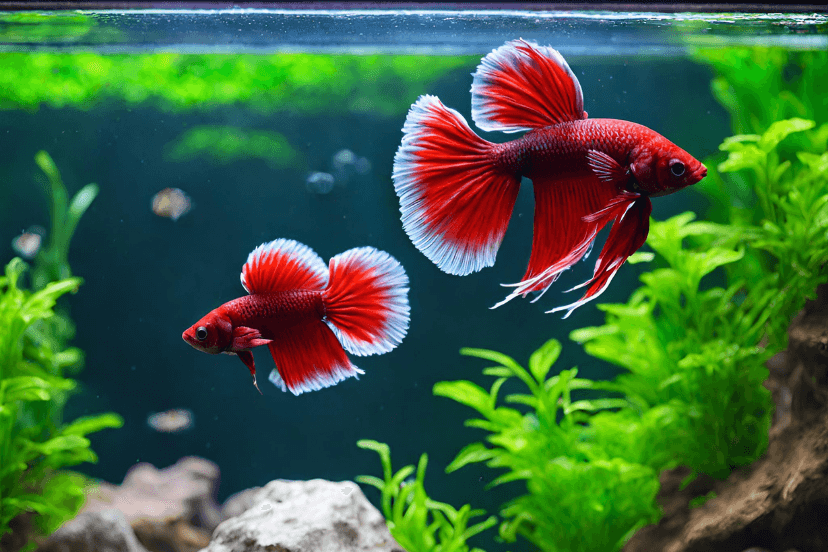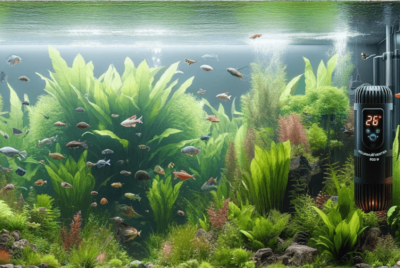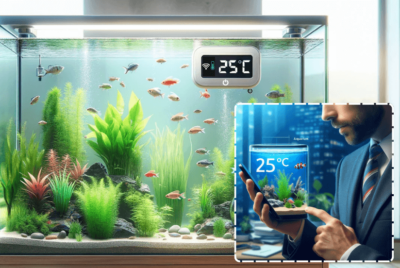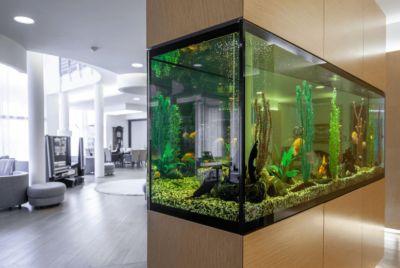Freshwater Fish Tank Setup: Quick How-To Tips
Embarking on the journey of setting up a freshwater fish tank is an exciting adventure that can transform any space into a vibrant slice of aquatic life. “Freshwater Fish Tank Setup: Quick How-To Tips” is your comprehensive guide designed to navigate through the process of establishing your own freshwater aquarium with ease and confidence. Whether you’re a novice aquarist dreaming of your first tank or an experienced enthusiast looking to refine your skills, this guide provides valuable insights and practical advice to ensure a successful setup.
Creating a thriving freshwater aquarium goes beyond just filling a tank with water and fish. It involves understanding the delicate balance of the aquatic ecosystem. Choosing the right equipment and providing the best care for your aquatic inhabitants are also crucial. Our guide is crafted with the beginner in mind, breaking down complex concepts into easy-to-follow steps. It offers quick tips that make the setup process not only manageable but also enjoyable. From selecting the right tank size and filtration system to introducing plants and fish, we cover all the essentials, ensuring your freshwater fish tank becomes a thriving, healthy environment for its inhabitants. Join us as we dive into the fascinating world of freshwater aquariums. Every step forward brings you closer to creating a captivating underwater oasis.
Getting Started
Why Choose a Freshwater Fish Tank?
Choosing a freshwater aquarium is an excellent entry point for newcomers to the aquarium hobby. It offers a more forgiving and cost-effective alternative to saltwater setups. Freshwater tanks appeal to a broad audience due to their lower initial setup and maintenance costs. They offer a diverse range of environments and species that can be explored. This diversity allows hobbyists to create highly personalized aquatic worlds. Ranging from serene planted tanks to bustling community aquariums, without the daunting expenses and complexities often associated with saltwater aquariums.
Beyond their budget-friendly appeal, freshwater aquariums serve as a rich educational platform. They introduce hobbyists to the intricacies of aquatic ecosystems and the care requirements of various species. They provide an ideal balance of accessibility for beginners and depth for more experienced aquarists looking to expand their knowledge. Engaging with a freshwater tank is not just about maintaining an aquarium. It’s about embarking on a journey of discovery and connection with nature. It offers endless opportunities for learning, enjoyment, and the satisfaction of nurturing a thriving aquatic environment.
The Difference Between Freshwater and Saltwater Fish Tanks
Diving into the world of aquariums brings you face-to-face with a pivotal choice. Should you start a freshwater fish tank or venture into the realm of saltwater aquariums? This decision not only influences the type of aquatic life you’ll care for. It also dictates the maintenance and equipment needed to sustain your underwater world. Understanding the fundamental differences between freshwater and saltwater fish tanks is essential for any aspiring aquarist. It guides you towards making an informed decision that aligns with your interests, budget, and level of commitment.
Freshwater Fish Tanks
Freshwater fish tanks are known for their simplicity and accessibility. This makes them a favored choice for both novice and experienced aquarium enthusiasts. With less complex water chemistry and a more straightforward setup process, these tanks allow hobbyists to easily create a diverse and thriving aquatic environment. Freshwater aquariums offer a broad range of species, from colorful fish to lush plants, that can coexist in harmony. This provides an excellent opportunity for beginners to learn essential fishkeeping skills without the intimidation of more complex requirements.
Saltwater Fish Tanks
Saltwater fish tanks, on the other hand, are celebrated for their breathtaking beauty and the ability to replicate marine ecosystems. These aquariums require a deeper understanding of marine biology and chemistry. They also require investment in specialized equipment to accurately mimic oceanic conditions. Despite the challenges, saltwater tanks reward dedicated aquarists with a stunning display of coral reefs and exotic marine life. They turn an aquarium into a captivating window to the wonders of the ocean. The commitment to maintaining a saltwater tank is met with the unparalleled joy of nurturing a piece of marine splendor.
Planning Your Freshwater Fish Tank

Selecting the Right Tank Size
Selecting the right size for your aquarium is a crucial step in setting up a successful and healthy aquatic environment. Larger aquariums are favored in the fishkeeping world due to their ability to maintain more stable water conditions, which is vital for the well-being of your aquatic inhabitants. This stability comes from the larger volume of water, which can buffer against rapid changes in temperature, pH, and other critical water parameters. Additionally, a spacious tank offers ample room for your fish to swim and thrive. This can potentially reduce stress and promote natural behaviors.
Moreover, while the initial setup of a larger tank might require a higher investment in equipment and energy. The long-term benefits often outweigh these costs. Larger tanks provide a more forgiving environment for beginners by offering a greater margin for error in maintenance and care. This aspect is particularly advantageous for those new to the hobby. It allows for a smoother learning curve in understanding the nuances of aquarium management. Ultimately, choosing a larger tank can lead to a more rewarding and engaging fishkeeping experience. It allows for a richer biodiversity within your aquatic ecosystem.
Essential Equipment Checklist
Embarking on the journey of setting up your own aquarium is an exciting venture. But before you dive into the aquatic world, it’s crucial to have all the necessary equipment on hand. Creating a thriving underwater ecosystem requires more than just water and fish. It demands a carefully curated selection of tools and devices to ensure the health and well-being of your aquatic life. Here’s an essential equipment checklist to get you started on the right fin:
- Aquarium Tank: The foundation of your aquatic ecosystem. Choose a size that fits your space and accommodates the type of fish and plants you wish to keep.
- Filtration System: Critical for maintaining water quality by removing toxins and debris. Select a filter with a capacity appropriate for your tank’s volume.
- Heater: Essential for tropical tanks to maintain a consistent temperature suitable for your fish species.
- Lighting: Proper lighting not only showcases your aquarium but is also vital for the growth of plants and the health of certain fish species.
- Substrate: The base layer of your aquarium, crucial for plant growth and beneficial bacteria development. Options vary from gravel to specialized aquatic soils.
- Water Test Kit: Allows you to monitor water parameters such as pH, ammonia, nitrite, and nitrate levels, ensuring a safe environment for your fish.
Equipping your aquarium with essentials like filters, substrates, and water test kits is crucial for a healthy ecosystem. Each component replicates natural habitats and supports aquatic life. Regular water testing prevents issues, ensuring stability. Prioritize these for a thriving aquarium.
Setting Up Your Freshwater Fish Tank
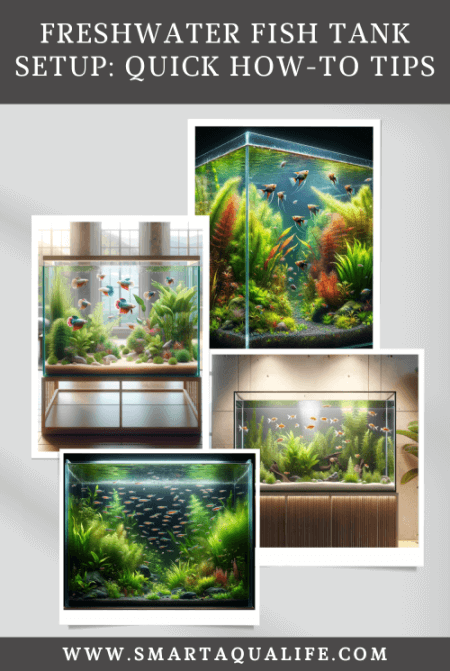
Setting up a freshwater aquarium is an exciting venture that transforms your space into a vibrant aquatic ecosystem. Following a step-by-step process ensures that your aquarium is not only visually appealing. It also creates a healthy environment for its inhabitants. From selecting the perfect spot to introducing your fish, each step plays a critical role in establishing a thriving aquatic world. Let’s dive into the essential steps needed to create a successful freshwater aquarium, laying the foundation for a rewarding fishkeeping experience.
- Choose a Stable Location: Begin by placing your tank on a stable surface in an area that avoids direct sunlight. This helps prevent algae growth and temperature fluctuations.
- Layer the Substrate: Select and layer your chosen substrate (gravel, sand, or specialized substrate) at the bottom of the tank, which is essential for plant growth and beneficial bacteria.
- Fill with Dechlorinated Water: Carefully fill your tank with dechlorinated water to remove harmful chemicals, ensuring a safe environment for your aquatic inhabitants.
- Install Essential Equipment: Set up your filter, heater, and lighting system according to the specific requirements of your aquarium to maintain optimal living conditions.
- Enhance with Plants and Decorations: Strategically place live plants and decorations to create natural hiding spots for your fish, contributing to their well-being and enhancing the tank’s aesthetic appeal.
- Cycle Your Aquarium: Allow your tank to cycle before adding fish, establishing a beneficial bacterial colony to break down waste, crucial for a healthy aquatic ecosystem.
Cycling Your Aquarium
Cycling your aquarium is a vital step in establishing a healthy environment for your aquatic life, involving the transformation of harmful waste into less toxic substances through the nitrogen cycle. This crucial process, taking approximately 4-6 weeks, requires patience and regular water testing to monitor levels of ammonia, nitrites, and nitrates, ensuring the tank becomes habitable for fish. Utilizing accurate aquarium test kits and considering beneficial bacteria starters can expedite this process, though natural cycling is preferred for its long-term stability benefits. Properly cycling your tank lays the foundation for a thriving aquatic ecosystem, highlighting the importance of this initial investment in time and care for the well-being of your underwater community.
Adding Fish and Plants
Choosing Your Fish
When selecting fish for your aquarium, it’s essential to start with species known for their resilience and suitability for beginners. Hardy, beginner-friendly fish like tetras, guppies, and bettas are excellent choices due to their ability to adapt to various conditions and their generally low maintenance requirements. Before making your selection, take into account factors such as the adult size of the fish, their temperament, and specific environmental needs. This foresight helps in creating a well-balanced and harmonious community within your tank, preventing potential conflicts and ensuring a healthy, thriving aquatic ecosystem. Choosing the right mix of species is crucial for both the well-being of your fish and the overall success of your aquarium.
Selecting Plants for Your Freshwater Fish Tank
Incorporating plants into your aquarium goes beyond mere aesthetics; they play a vital role in maintaining the ecological balance of your tank. When selecting plants, it’s important to choose species that align with the lighting conditions of your aquarium and your willingness to perform maintenance. Different plants require varying levels of light and care, from low-light tolerant ferns and mosses to high-light demanding aquatic plants. Opting for plants that fit your tank’s environment and your capacity for upkeep ensures they thrive, contributing to oxygen production, toxin absorption, and providing shelter and breeding grounds for your fish. Thoughtfully selected aquarium plants can transform your tank into a vibrant, healthy ecosystem, enhancing both its beauty and functionality..
Maintaining Your Freshwater Fish Tank
Regular Maintenance Tasks
Maintaining a healthy aquarium requires consistent care and attention to a few critical tasks. Regular water changes are paramount; they remove toxins and replenish essential minerals, ensuring the water quality remains optimal for your aquatic inhabitants. Alongside water changes, vacuuming the substrate helps to eliminate food debris and waste, preventing the accumulation of harmful ammonia and nitrite levels.
Additionally, filter maintenance is crucial for keeping the water clean and aerated. Cleaning or replacing filter media as recommended by the manufacturer prevents clogs and ensures the filter operates efficiently. Together, these regular maintenance tasks form the backbone of a thriving aquarium ecosystem, promoting the health and well-being of your fish and plants.
Monitoring Water Quality
Monitoring water quality is a critical aspect of maintaining a healthy aquarium. It’s essential to regularly check the levels of ammonia, nitrite, and nitrate, as these compounds can become toxic to fish if allowed to accumulate. Keeping tabs on the pH and temperature of the water is equally important, as sudden shifts in these parameters can stress or even harm your aquatic life. Any significant change in these water quality indicators can signal underlying problems that require immediate attention to prevent health issues within your aquarium ecosystem. By staying vigilant and addressing any discrepancies promptly, you can ensure a stable and safe environment for your fish and plants.
The Risks of Smart Aquarium Technology
Understanding the Risks
The integration of smart aquarium technology has revolutionized the way we manage and interact with our aquatic environments, offering unprecedented convenience and precision in monitoring and controlling various parameters within the tank. However, it’s crucial to understand the potential risks associated with over-reliance on these advanced systems. While they can significantly simplify aspects of aquarium care, such as regulating temperature, lighting, and filtration, there’s a risk that they might fail. A malfunction in these smart systems can lead to rapid deterioration of water quality and potentially endanger the lives of the aquatic inhabitants.
Moreover, the convenience of smart technology might inadvertently encourage aquarists to overlook the importance of manual checks and maintenance. This over-dependence can mask underlying issues that automated systems might not detect, such as the subtle signs of stress or disease in fish, or the gradual accumulation of detritus not caught by filters. In essence, while smart aquarium technology can enhance the fishkeeping experience, it’s vital to balance its use with regular, hands-on care to ensure the long-term health and stability of your aquatic ecosystem.
Balancing Technology and Hands-on Care
Optimizing aquarium care requires a balanced approach that integrates technology with hands-on checks. While technological advancements offer convenience and efficiency, they should supplement rather than replace personal involvement. Automated systems can aid in tasks like feeding and filtration, but regular hands-on checks remain essential for maintaining a close connection to the aquarium’s health and promptly addressing any issues that may arise. By combining the benefits of technology with manual inspections, enthusiasts can ensure the long-term well-being of their aquatic ecosystems.
Troubleshooting Common Issues
When it comes to maintaining a healthy aquarium environment, common issues like algae outbreaks and unexplained fish losses often trace back to water quality concerns. Regular testing and maintenance routines serve as your primary defense against these problems. By diligently monitoring water parameters and conducting routine upkeep, you can identify and address potential issues before they escalate, safeguarding the well-being of your aquatic inhabitants. Whether it’s adjusting filtration systems, performing water changes, or implementing algae control measures, proactive management is key to ensuring a thriving aquarium ecosystem.
Conclusion
Embarking on the journey of setting up your freshwater fish tank is an exhilarating experience filled with endless possibilities. As you begin this adventure, it’s important to approach it with patience and care, understanding that creating a thriving underwater world takes time and dedication. Every aquarist, no matter how experienced they are now, started as a beginner like you. Embrace this learning process, and with each step, you’ll gain valuable insights and skills that will transform you into a seasoned keeper of your aquatic haven.
Remember, building and maintaining a freshwater fish tank is a journey, not a race. Take the time to research and understand the needs of your fish and plants, ensuring you provide them with the optimal environment for growth and happiness. With dedication, patience, and a willingness to learn, you’ll soon find yourself immersed in the rewarding experience of caring for your own slice of underwater paradise.

FAQs
Q: What is the easiest freshwater fish to care for?
A: Guppies are colorful, hardy, and perfect for beginners.
Q: How often should I change the water in my aquarium?
A: Aim for 10-20% weekly to keep conditions optimal.
Q: Can I mix different types of fish in my tank?
A: Yes, but research compatibility to ensure peaceful cohabitation.
Q: What’s the best way to ensure my plants thrive?
A: Choose plants suited to your tank’s light level and consider liquid fertilizers.
Q: How do I know if my aquarium is well-cycled?
A: When ammonia and nitrite levels are 0, and nitrates are present but low, your tank is cycled.

